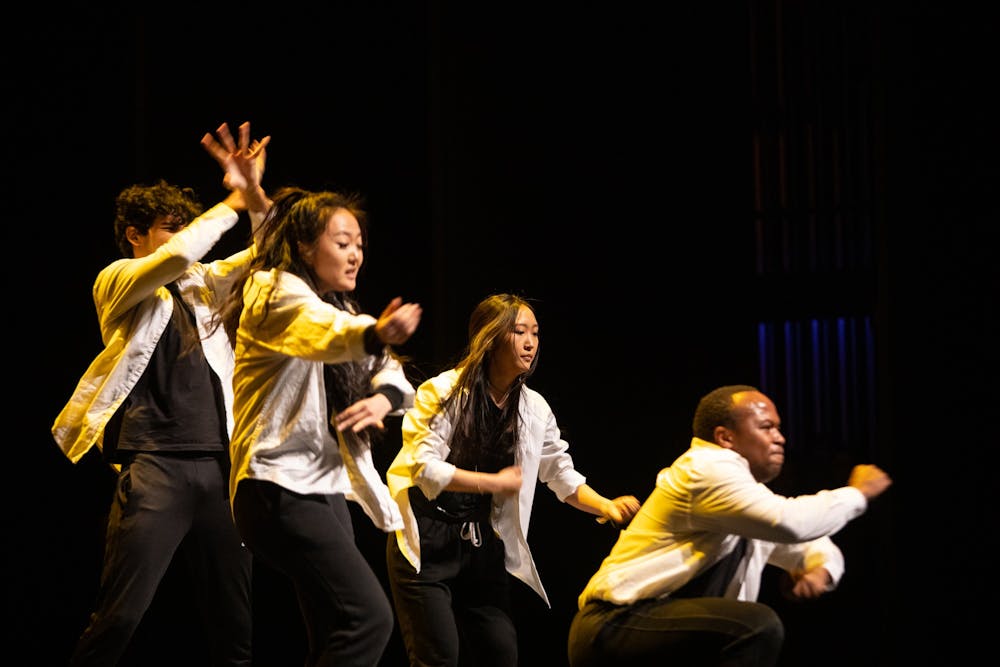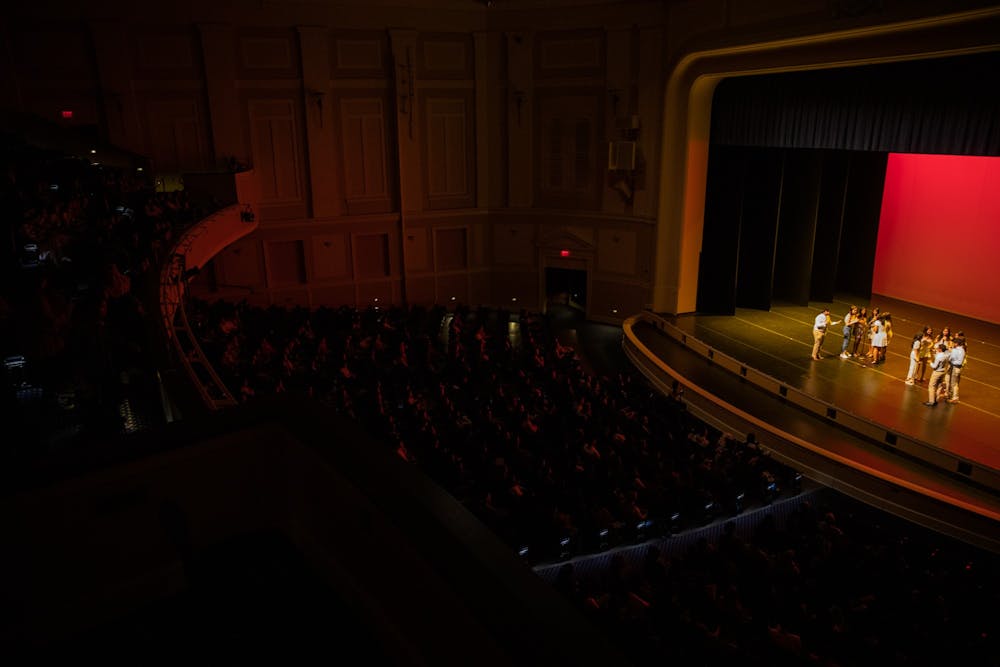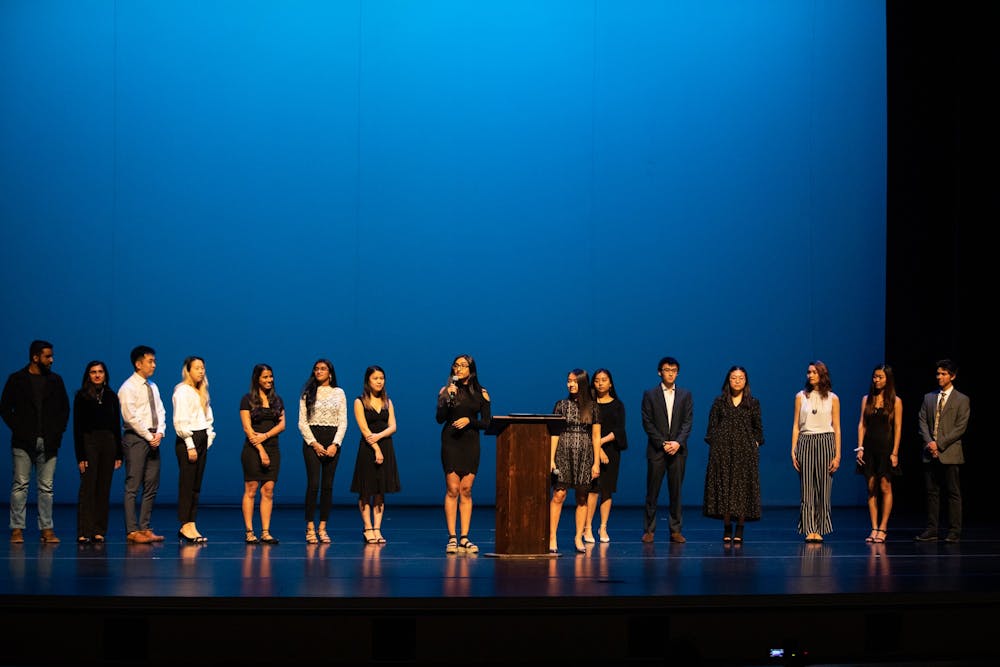Journey Into Asia, the largest cultural showcase at UNC, has been hosted by UNC AASA since 1992.
AASA’s Cultural Co-Chair Aayush Purohit said Journey Into Asia’s mission is to bring to light issues that are often overlooked. This year’s iteration of Journey Into Asia did just that — addressing the lack of Asian American representation in the media.
The official theme of this year’s event was #As-1-anAmerican: simultaneously a play on “Asian” and a response to #OscarsSoWhite, which trended four years ago in response to the lack of the diversity at the Academy Awards.
 Buy Photos
Buy Photos
The event challenged preconceived notions that Asian Americans are only meant to fit certain roles, said Jonathan Liao, a cultural chair for UNC AASA.
The event also offered a chance for Asian Americans to showcase their culture on their own terms in a space in which they have been traditionally unrepresented, Purohit said.
“It’s about how they can either represent themselves in fields when they aren’t present in, but it’s also about being able to portray their cultures in the correct way — in a way that hasn’t been represented by Hollywood,” Purohit said.
The theme #As-1-anAmerican unified the 10 performances from students at UNC and Duke University. But the theme was primarily a guide for each of the groups, Purohit said.
Journey Into Asia granted each group freedom of expression in choosing what aspects of their culture to showcase, in whatever light they saw fit.
In between each of the performances, the two hosts of the evening, Kelly He and Moonwon Seo, relayed personal stories of growing up as an Asian American.
The hosts also cited examples of Asian Americans breaking this “bamboo ceiling” today, such as Lana Condor, a Vietnamese American actress and star of "To All the Boys I’ve Loved Before," and the team behind "Parasite," which won four of the six nominations it received at the 2020 Academy Awards.
Each group was introduced by a video, going behind the scenes of the rehearsal process and explaining the message behind each of the pieces.
 Buy Photos
Buy Photos
UNC Samaa, the first South Asian fusion a cappella group in North Carolina, performed two mash-ups, each between a popular South Asian song and a popular Western song.
“We always perform mash-ups, so it’s always about thinking about how we can blend two pieces together and find common themes and similarities, even though they’re from two different parts of the world,” said Maina Edula, a member of Samaa.
The members of Samaa come from a variety of backgrounds both culturally and musically, Edula said.
“We find a way to come together as one, and make beautiful music,” Edula said.
 Buy Photos
Buy Photos
The Duke a cappella group, the Temptasians, focused on representation of Asian music.
Temptasians member Andrew Zheng said their set challenged the dominant ideas of Asian music, often thought of in two extremes — dramatic orchestral strings, exemplified by the score to movies like “Mulan,” or K-pop, from bands like BTS or Blackpink.
“Just like music here in the States and in Western cultures, there is so much variety, and so many different essences that you can find within Chinese, Korean, Japanese — all of that music, that is still left to be explored,” Zheng said.
 Buy Photos
Buy Photos
Duke Chinese Dance performed a piece entitled “One.” The piece was inspired by Lulu Wang’s film “The Farewell,” which depicts the ideological barriers between generations of Asian American families. The piece also commented on the dual identity of being from Asia and from the United States.
“Being Asian American is a very unique experience, in the sense that it hasn’t really existed in history before,” Dong said.
“One” depicts the generational conflict between collectivism and individualism through formations and synchronicity, said Cynthia Dong, one of the performers in the piece.
“There’s this idea that Chinese culture in particular is very collectivist — you do what’s right for your family, you do what’s right for your country,” Dong said. “But Americans are more individualist."
The piece moved through three movements. The first involved the group moving together, precise and in sync. But as the piece progressed, the choreography grew more complex, moving less as a group and more as individual dancers.
 Buy Photos
Buy Photos
The campaign team for the Asian American Center also spoke at Journey Into Asia.
“Whether in the United States, in the South or in North Carolina, this year’s JIA makes it clear that Asian Americans lack proper representation in society, and the Asian American Center wants to change that,” said Preeyanka Rao, the campaign’s co-director of development.
Sara Holley, co-director of strategic communications, said advocacy for an Asian American resource center started in 1994, when her parents were juniors at UNC. Now, Holley is a junior.
“I was brought to tears when the Board of Trustees authorized the establishment of the AAC because this is our generations of students’ push to do just that — to make Carolina feel more like home — to make it an even better experience for the students who come to this campus after us,” Holley said.
Rao said Asian Americans are underrepresented at UNC, citing a lack of staff members, resources and a permanent physical space.
According to data from UNC, 18 percent of the Fall 2019 first year class identifies as either Asian or Asian American; and in 2018, 11 percent of tenured, tenure track and fixed term faculty identify as Asian, according to data from UNC.
 Buy Photos
Buy Photos
The campaign for the Asian American Center aims to promote Asian American voices and raise $1.2 million by fall 2020 to open the center. Holley said they have currently raised over a third of this amount.
Chancellor Kevin Guskiewicz attended Journey Into Asia on Saturday.
“Our Asian American community is really critical to diversity on campus,” Guskiewicz said. “They represent the highest percentage of underrepresented students on our campus, and I’m very excited that we’re starting our Asian American Center," he said.
"come" - Google News
March 02, 2020 at 09:18AM
https://ift.tt/38k06tH
'A way to come together as one': Journey Into Asia challenged lack of representation - The Daily Tar Heel
"come" - Google News
https://ift.tt/2S8UtrZ
Shoes Man Tutorial
Pos News Update
Meme Update
Korean Entertainment News
Japan News Update
Bagikan Berita Ini














0 Response to "'A way to come together as one': Journey Into Asia challenged lack of representation - The Daily Tar Heel"
Post a Comment